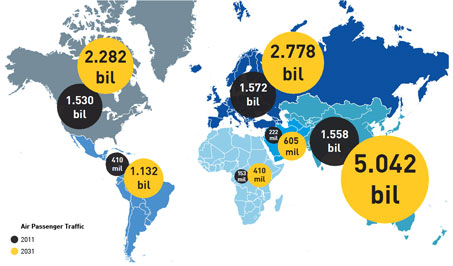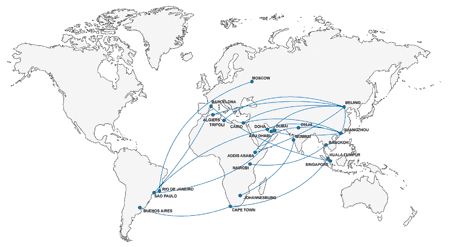
Amid the ongoing economic turmoil in the Eurozone and the regular reminders that the future of aviation is East, the European Commission (EC) has recently developed a renewed strategic approach, taking stock that aviation is a key enabler of growth. It has repeatedly issued warnings about a shift in the world economy towards Asia and Latin America and how this is challenging the primary positioning of the European aviation market.
With these developments in mind, on 27 September, the European Commission announced through a formal Communication an ambitious plan to open negotiations with key EU trading partners, to access new business opportunities in fast growing markets. It is making the case for negotiating new aviation agreements with the EU’s major trading partners so as to secure market access opportunities under fair, competitive conditions. The Commission is also looking at the timely completion of a Pan-European/Mediterranean Open Aviation Area with the EU’s neighbouring countries by 2015 – a high priority for Europe’s regional airports given the underlying potential for traffic growth with these markets.
In all, this ambitious agenda involves agreements with countries such as China, Russia, India, the ASEAN grouping in south-east Asia and certain Gulf countries, but also includes the goal of completing by 2015 an umbrella of aviation agreements with neighbouring EU countries such as Turkey, Ukraine, Egypt and others.
Launching the initiative, European Commission Vice-President in charge of Transport, Siim Kallas referred to the shift taking place in global aviation: “The European aviation industry has been hard hit by recession and if that was not enough, global aviation is changing rapidly. Half of the world’s new traffic during the next 20 years will be to, from or within the Asia-Pacific region.”
ACI EUROPE has pushed for this initiative for some time now, publishing its own analysis & strategy paper “Expanding Europe’s Aviation Market” specifically concerning aviation liberalisation last year and it warmly welcomed this latest move by the EC in a press release. Alongside the negotiation proposals, ACI EUROPE also commended the EC’s parallel commitment to enhancing the competitive position of European aviation, both internally and externally, with Director General Olivier Jankovec reminding that this must include a renewed focus on addressing the airport capacity crunch, and the damage being wrought by national aviation taxes.
Europe’s airports have long considered that the system of restrictive bilateral agreements regulating aviation relations between individual EU Member States and the rest of the world is anti-competitive and hinders the ability of the sector to deliver increased consumer benefits and economic growth. For airports, bilateral agreements still too often obstruct their ability to attract new air services, diversify their traffic mix and improve the connectivity of their communities.
ACI EUROPE Director General Olivier Jankovec said “There is no question that we need to speed-up the pace of aviation liberalisation. If we want to attract and develop air traffic flows and improve connectivity with our external markets, the only effective way to do it is through EU-led negotiations. This is about maintaining our global relevance. This is crucial not just for European aviation but for our economies at large.”
The Commission rightly points to the need for more liberalisation to go hand in hand with a focus on increasing the competitive position of European aviation both internally and externally. This requires more alignment of aviation policy at all levels, with a particular focus on addressing damaging aviation taxes and giving airports their license to grow given the looming airport capacity crunch.
Jankovec further commented “Ensuring a fair level playing field is paramount to protecting the hub positioning of Europe. But we also need to be realistic and strike the right balance between fair competition and market access. In other words, this cannot be an excuse for systematically blocking negotiations and holding back the ripple effect of wider liberalisation benefits.”
The Commission’s Communication is now being reviewed by the EU Member States through the Council. Endorsement is indispensable since it is still the Council that needs to grant the Commission permission to initiate negotiations and conclude aviation agreements with non-EU countries. It remains to be seen whether Member States will effectively support the mission’s new strategy and “play the European game”. Some prominent national airlines are notoriously opposed to any liberalisation with prominent emerging markets, preferring to keep the cosy arrangements and sometimes exclusive traffic rights that existing bilateral agreements give them.

Direct routes between emerging markets established between 2007 & 2010.
The ETS angle
One helpful development since this announcement has been with regard to aviation’s inclusion in the EU Emissions Trading Scheme (ETS). In the past year, various international governments have decried the inclusion of their intercontinental airlines in the ETS, with some very harsh words and entrenched positions. On 12 November, European Commissioner for Climate Action, Connie Hedegaard formally suspended the inclusion of non-EU airlines into the ETS for a period of one year, so that ICAO can advance with developing its own global emissions scheme.
This issue is understood to have been casting a shadow on a number of the EU’s international political discussions in the past year. Consequently, the EC’s willingness to suspend the application of non-EU carriers’ inclusion in the ETS for a year should buy it some goodwill for any potential discussions with third countries about aviation liberalisation.
The EC estimates that expanded aviation markets would add €12 billion to the €365 billion industry that already provides 5.1 million jobs. In the immediacy, it will consult with Member States in the Council of EU Transport Ministers in December, with a view to moving forward with the proposals in early 2013.
For more information, go to the European Commission’s DG MOVE website:
http://ec.europa.eu/transport/modes/air/international_aviation/index_en.htm







